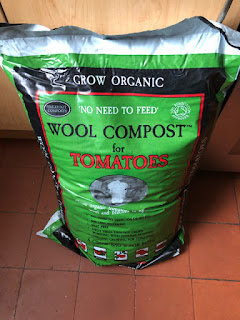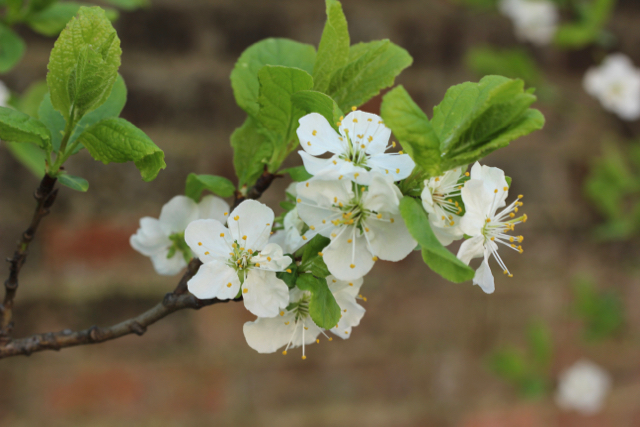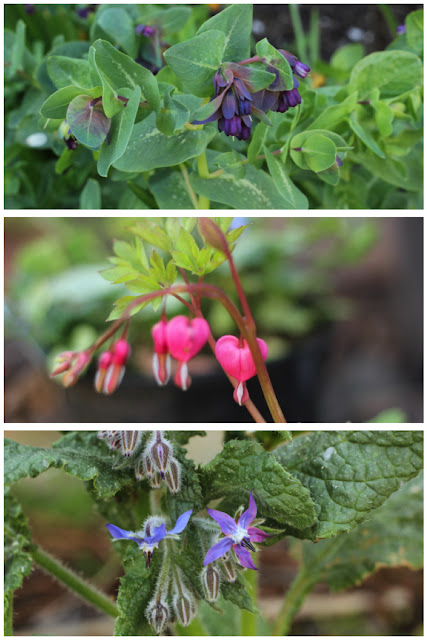 |
| Summer 2018 - Balcony bush tomato |
Last summer, as usual, I used the balcony to sow, grow and pot on my tomato plants into 10 litre pots (15 litres might have been better) with the intention of moving them down to the veg patch after hardening off. As they grew, and I appreciated the ease of watering them in last summer's heatwave, I could see how well they responded to the warmth and attention they got by being close to hand. There was no problem with weekly feeding (#feedonfriday) as I had everything I needed nearby. And, once they started fruiting, I loved that I could pop outside and pick a few cherry tomatoes to add to a salad - or to eat as a quick snack - without interrupting my work for long.
Even in those 10 litre pots I had a selection of tomatoes to pick from all summer long. One bush cherry tomato plant gave up its last fruit in mid November, although that was probably a fluke given the hot summer and extended warm autumn we had here in the UK.
So now I'm hooked. There will be balcony tomatoes again this year - some small, some tall - but they're all suitable for growing in pots, containers or 'a windowsill garden' which I think sounds rather charming. I'll fit as many as I can on the balcony and, if they all germinate, pop a few next to the veg patch and hopefully have some to give away.
Sowing and growing with peat free Dalefoot compost
I've only just sown the seeds, putting up to 6 seeds of each variety in a 9cm pot filled with Dalefoot Wool Compost for Seeds. When they've got their first set of true leaves, the tomato babies can be pricked out into individual 9cm pots of Dalefoot Wool Compost for Veg and Salads. Once the roots fill those pots, I'll pot them on into a size bigger pot and then into the final plant pot when first flowers appear.
I'm really quite excited to reach that final planting out stage as I've been gifted a bag of Dalefoot's new Wool Compost for Tomatoes. The nutrient rich compost has been formulated so that there is 'No Need to Feed' (awesome) through the entire season, plus with 50% less watering thanks to the wool content, there are time and ecological savings there too. Hot summer or not, using less water is a positive step for the planet's dwindling resources.
I've been impressed with Dalefoot products in the past so I'm confident that this latest addition to the Dalefoot canon will deliver on its promises. They're now fully accredited by the Soil Association for their organic peat free composts; not only that but the company are actively involved in work to restore peat bogs. What I hadn't fully understood was the extent to which removing peat from the land contributes to climate change and, by leaving peat in place, water quality is maintained and natural flood prevention prevails. Sounds to me like a compelling reason to use peat free compost. But I digress ...
My tiny tomato choices for 2019
There's plenty of time (until the end of May) to sow tomatoes, bearing in mind that freshly picked will always taste better than shop bought, plus you get that lovely smell from the (slightly poisonous) leaves. (No? Just me, then.)
These are the plants that I'm growing.
- Cherry Falls, Mr Fothergill's - 'perfect for outside baskets and tubs'
- Balconi Red, Thompson & Morgan - 'plant height 12", very sweet, for indoor and outdoor cropping'
- Minibel from Johnsons - 'very compact, outdoor plants ideal for patio pots'
- Lizzano F1, Marshalls - 'Prolific cropping hanging basket variety' - perfectly shaped to fill and spill.
- Rainbow Blend, T&M, as above - 'early ripening, good crop throughout the summer'. But here's an anomaly I didn't spot before: the pack says plant height 8" but the website tells me the plant grows to 200cm or 78.7 inches. Curious. Also, 5 seeds for £3.69? I must have had my head in the clouds on that day but at 74p a seed, they'd better all germinate!
- Red Currant, Dobies Rob Smith Heritage Veg range - 'very disease resistant tiny tomatoes. Good tolerance to cooler temperatures'. Hardly changed since found growing wild on a Peruvian beach in 1707 but, oh dear, another cordon that I missed. Will grow to 1.5 or 2 metres. But still okay in a pot. That's alright then.
- Patio Plum - a baby plum with 'bite' and 'sharp acidic flesh that gives a real kick'
- Summerlast F1 - one for the patio or window-garden, late blight resistance. Harvest by the punnet!
- Arielle F1 - 'Grow your own sun dried tomatoes'. Fruits will dry on the vine if not harvested, and start to look like raisins. Or sun-dried tomatoes. Also a cordon, grows to 4ft.
For clarity: Apart from the Thompson & Morgan seeds which I bought when drifting through the shop at Kew Gardens, all the other packets were given to me to trial after chatting to the companies at the Garden Press Event.
I'm not affiliated to any of the companies so when I review the plants at the end of the year, my opinions will be entirely impartial.










